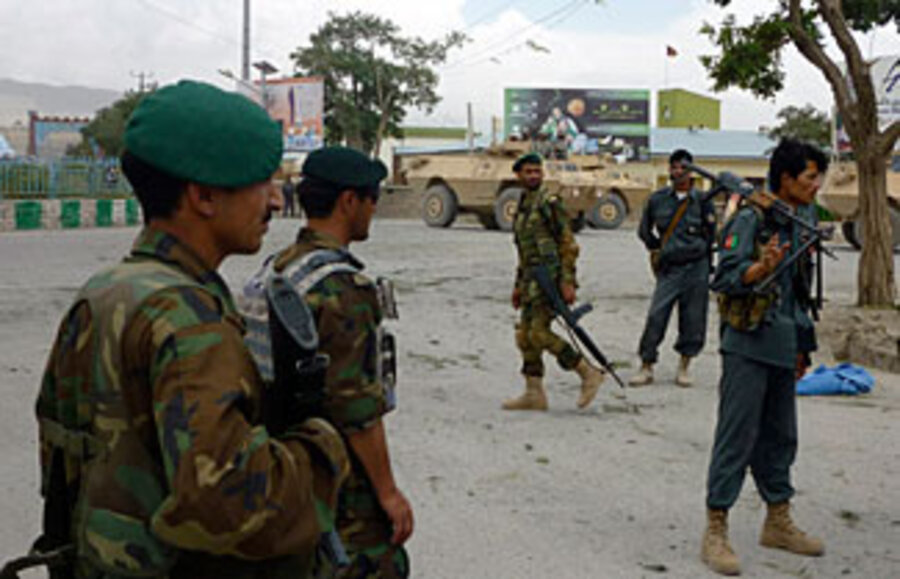Thwarted Taliban attacks a positive mark in Afghan police’s spotty record
Loading...
| Kabul, Afghanistan
Afghan security forces thwarted a series of coordinated suicide attacks on government installations in Gardez Tuesday, preventing the higher casualties that similar attacks have caused and showing potential progress in their antiterror capabilities.
According to initial reports, at least eight suicide bombers launched attacks in two eastern cities: six targeted three government compounds in Gardez, and two attempted to hit a military outpost near Jalalabad.
Though two of the militants detonated their explosives, at least five were killed. At least four Afghan security forces were killed. No civilian casualties were reported.
The Taliban, which claimed responsibility for the attack, said it had sent 15 suicide bombers to Gardez.
"The good news from my end is that the execution of these attacks were so poorly done and decisively defeated in the early stages that the Afghans have a right to be proud," says Tim Lynch, a security expert now contracting for USAID, with offices in Gardez and Jalalabad.
"Does this give me hope for the future? Yeah," he continues, though he notes that the police's overall performance is still "spotty."
'Only two blew themselves up'
The familiar pattern of attack, which militants had adopted more successfully on previous occasions, involves firing on the security personnel at the gates, then storming inside and detonating explosives to kill the maximum number of people. A similar attack in the eastern city of Khost in May, involving 11 suicide bombers, killed 20 people and wounded three American troops.
In Gardez, the insurgents assaulted the governor's compound, a police station, and the National Security Directorate (the intelligence department) with gunfire and rocket attacks. Only two of the attackers were able to detonate their explosives, however, one at the NSD and another at the police station, according to Ministry of Interior spokesman Zemarai Bashary.
There were conflicting reports on the number of casualties, but according to Mr. Bashary, four insurgents were shot dead by intelligence officials and the Afghan police. Two intelligence officials and two police officials were also killed and six wounded, he says.
At least two of the attackers wore burqas, which help hide the explosives. "Picking something like [the burqa-disguised attacker] out of the normal daily clutter: That's not bad," says Mr. Lynch.
In Jalalabad, locals informed the police of the suspicious movement of two men on a motorcycle. Police chased the men up to the gates of the one of the United States forward operating bases, where one of the insurgents was killed.
There were conflicting reports on the second man, though NATO and US forces said he had been captured. A NATO spokesperson said NATO had worked to "assist the ANSF [Afghan National Security Forces] in preventing and stopping the attack in Jalalabad."
Tuesday's attacks were "a terrible thing, but the good thing is that out of the eight bombers, only two blew themselves up," says Bashary. "This represents enhanced capacity on the part of the Afghan National Security Forces."
Lt. Cmdr. Christine Sidenstricker, a spokesperson for the US military, says the success in thwarting the attacks and preventing high casualties was "a step forward."
"I don't want to draw conclusions from a single incident," she says, but "we are seeing more and more capability and more and more operations led by ANSF."
Attacks come amid surge in violence
The attack on the governor's compound in Gardez took place as senior officials there were wrapping up a meeting to discuss security. Violence has spiked ahead of the Aug. 20 presidential election, as more US troops pour into the country.
The European Union's foreign policy chief, Javier Solana, who was in Kabul Tuesday, acknowledged that "elections are going to take place in a difficult environment."
• Staff writer Ben Arnoldy contributed to this report.





